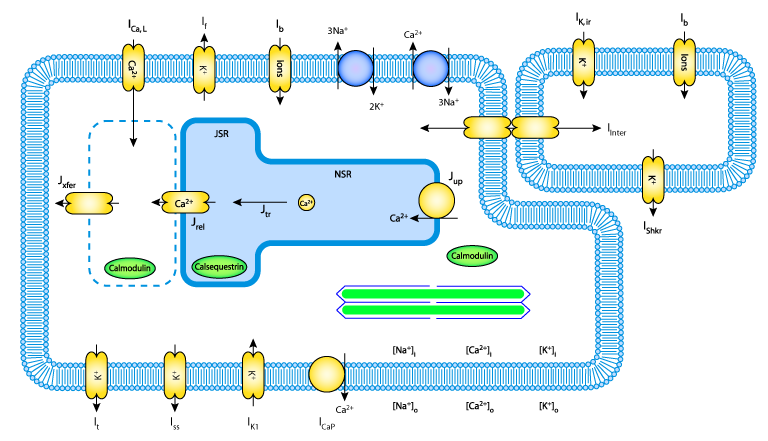Sachse, Moreno, Abildskov, 2008
Model Status
This CellML version of the model runs in PCEnv, COR and JSim to recreate the results in the Figure 7 of the publication. The CVode integrator needs to be used in Jsim to run this model. The units have been checked and are consistent, and we would like to thank Frank Sachse, the original model author, for his advice and assistance in getting the CellML version of this model working. This CellML model represents the coupled fibroblast-myocyte model, 1:1 ratio. This ratio can be changed by altering the value of the variable 'number_of_fibroblasts' in the component 'I_inter'.
Model Structure
Fibroblasts are the most abundant cell type present in the heart. They are arranged in the myocardium, as a three-dimensional network, where they are responsible for the secretion of extracellular matrix proteins, and also play a role in cardiac electrophysiology. Although fibroblasts themselves are electrically in-excitable, they can contribute to the electrophysiology of neighbouring myocytes through fibroblast-myocyte coupling. Although the electrical coupling of fibroblasts and myocytes has been demonstrated experimentally both in vivo and in vitro, the precise role of fibroblasts as electrical bridges between myocytes still remains to be defined.
In the paper described here, Frank Sachse, Alonso Moreno and J. A. Abildskov address this issue by presenting mathematical models of cellular and multi-cellular electrophysiology. A novel mathematical model of cardiac fibroblasts was developed on the basis of experimental data from whole cell patch clamp and polymerase chain reaction studies. This model was then applied, together with models of ventricular myocytes (which were based on the Pandit et al. 2001 model of the rat left ventricular myocyte), to determine the electrophysiological effects of heterogeneous electrical coupling of cells.
 |
| Schematic diagram of the fibroblast cell model. A Markovian model for the time and voltage dependent outward current (ISHkr) is embedded within an electrophysiological cell model. The ion channel has six different states; five closed states (C0-4) and one open state (O) |
The original paper reference is cited below:
Electrophysiological Modeling of Fibroblasts and Their Interaction with Myocytes, F.B. Sachse, A.P. Moreno, and J.A. Abildskov, 2008, JanAnnals of Biomedical Engineering PubMed ID: 17999190
